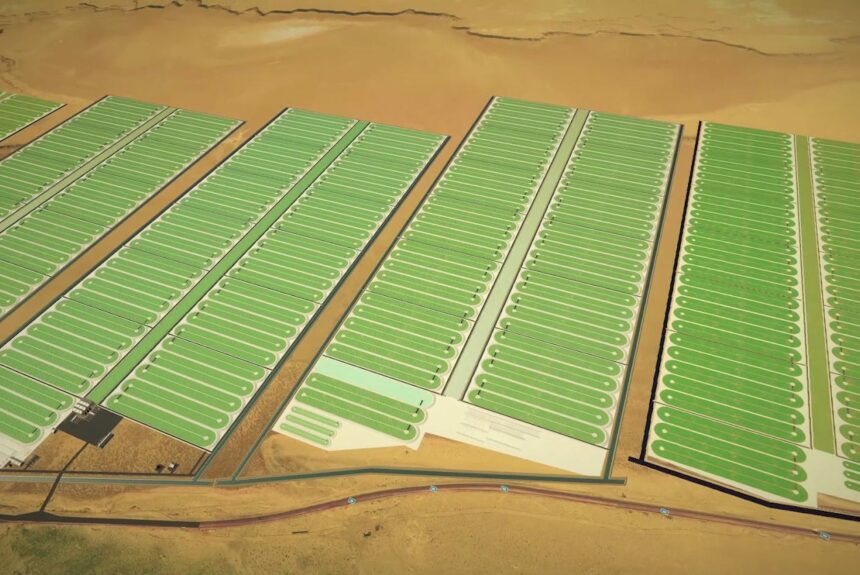The oceans play a crucial role in tempering the effects of climate change by serving as a critical carbon sink, absorbing vast amounts of carbon dioxide (CO2). Algae is an invaluable contributor to this process as its responsible for one-fifth of the global carbon cycle. These photosynthetic plant-like organisms are up to 50 times more efficient at trapping CO2 than terrestrial flora per unit area and grow exceptionally fast under the right conditions. These features are attracting entrepreneurs, companies, and investors who want to accelerate the plants’ natural carbon sequestration functions.
>>>READ: Seaweed Could Change Packaging As We Know It
A key player in this market is Brilliant Planet, a UK-based climate technology company. The startup aims to harness the power of marine algae to remove emissions by the gigaton, and then sell its service within the broader carbon marketplace. Brilliant Planet relies on a mix of modern engineering coupled with the carbon-capturing capacities of some of the world’s most ancient aquatic organisms.
The startup essentially replicates the natural algal coastal blooms that sustain marine ecosystems –– albeit on land. Adam Taylor, CEO of Brilliant Planet, claims that the company has devised a method to exponentially cultivate the organisms, commencing in a laboratory beaker and culminating in 12,000-square-meter pools of locally sourced seawater. Taylor asserts that the process emulates natural algae bloom, with a single test tube of algae proliferating to occupy 16 of these extensive pools—equivalent to 77 Olympic-sized swimming pools—in just 30 days.
The first step to emulating and enhancing this natural process is to grow an algal “starter” batch under highly controlled environmental conditions in the lab. In Brilliant Planet’s case, this means growing the monoculture in its seven-acre pilot site in Akhfennir, Morocco, a tranquil coastal desert town.
After its incubation in the lab, the algae is transitioned to a semi-enclosed greenhouse, where it can grow exponentially while adapting to the local environment. The organisms are then transferred to expansive outdoor ponds, where nearly 90% of the total growth takes place.
With the help of wind power, Brilliant Planet pumps nutrient-rich seawater into these open-air ponds, nurturing the microalgae until they reach harvest readiness.
Back to the lab. Advanced filtration technology enables Brilliant Planet to harvest a concentrated seaweed ‘slurry,’ while the filtered seawater is safely reintegrated into the ocean after undergoing de-acidification. Finally, the algae biomass is solar-dried and permanently buried underground, a process that securely locks away the carbon for millennia. Thanks to its high salt content and other properties that counteract degradation, the carbon-loaded material maintains exceptional stability over time.
The entire process is powered by seawater and sunlight, enabling Brilliant Plant to capitalize on a highly efficient, nature-driven system with minimal input year-round. Additionally, the algae is readily verifiable and quantifiable; scientists simply weigh the biomass prior to burial and determine the amount of CO2 removed via physical sampling. Post-burial, high-tech sensors ensure there is no decay. Brilliant Planet is also working with independent verifiers like Isometric to develop a data reporting platform accessible to the public so that third-party buyers can be confident about the quality of the credits they buy.
“Algae are the unsung heroes of carbon removal,” Taylor explains. “Algae are inherently more efficient carbon removal machines than terrestrial plants as they don’t need to waste biological resources on building a supporting infrastructure of trunks, roots and branches –– their entire surface area is dedicated to photosynthesis.”
“Seasonal algae blooms can transform thousands of square kilometers of ocean into very high productivity systems in just a few days,” Taylor notes.
Brilliant Planet says that its facilities capture 30 times more carbon per year than an equivalent area of forest, all without encroaching on arable land (the company has pinpointed approximately 500,000 square kilometers of space around the globe where it can host its algae pools). And by allowing photosynthesis to do the hard work of carbon removal, Brilliant Planet says its energy and overhead costs are kept to a minimum.
Compared to other carbon dioxide removal (CDR) strategies on the market like Direct Air Capture, Taylor says his company can sequester CO2 for around one-tenth of the price.
>>>READ: Can this Green Aviation Startup Deliver Truly Clean Flying?
The sustainability startup hopes to sell its service for around $100 a ton in the voluntary carbon market. Brilliant Planet already has a few major corporate buyers looking to offset their emissions in the ranks, including global financial services firm Block. Block has commissioned Brilliant Planet to eliminate 1,500 tons of carbon by 2027 at its upcoming demonstration site in southern Morocco.
Since its founding in 2013, the algaculture firm has secured a remarkable $26.7 million in funding through high-profile rounds, with notable contributions from investors such as Toyota Ventures and USV. In its most recent Series A round in 2022, the company successfully raised $12 million in capital. Looking ahead, additional funding is anticipated this year, coinciding with the commencement of construction for a 30-hectare demonstration facility in Morocco, scheduled to begin in the second quarter.
Buoyed by a bullish carbon market, corporate demand for high-quality carbon credits continues to surge. A global carbon removal strategy that leverages the CO2-absorbing potential of algae with the reliability and quantifiability of man-made systems could be key to solving the climate challenge.
Nathalie Voit is a freelance content creator and a graduate of the University of Florida. She is an alumni of The Heritage Foundation’s Young Leaders Program.
The views and opinions expressed are those of the author’s and do not necessarily reflect the official policy or position of C3.
